Solitary Bees 101: The Lonely World Of The Flower Bee
Bees have probably been around since just after the first flowering plants appeared – and fossils date back to the Cenozoic.
Bees are not only cute, but are extremely important to the ecology of most habitats: as they are the primary pollinators of entomophilous plants (entomophilous plants are plants pollinated by insects; in comparison with anemophilous plants, which are pollinated by the wind).
They are therefore of inestimable economic importance as well. In America, millions of solitary bees of the family Megachile are farmed and looked after every year because of their pollination services. They have biting chewing mouth parts and two pairs of wings, of which the hind pair are generally smaller.
Bees vs Wasps
The main difference between Bees and Wasps is that Bees feed their larvae on ‘honey’, a mixture of pollen and nectar – which they have collected from flowers. Whereas Wasps feed their larvae on meat, mostly paralysed arthropods (the exception to this rule is a small family of wasps called the Masarinae who feed their larvae on a pollen nectar mixture).
If you get to look at them under a microscope you will see another difference. i.e. Bees always have some, often many, ‘plumose’ or ‘feather-like’ hairs, these help in collecting pollen; Wasps always have only un-branched hairs like you and me. Bees originated from hunting wasps (Sphecoidea).
Solitariness
There are more than 20,000 known species of Bee in the world and by far the greatest portion of these are solitary.
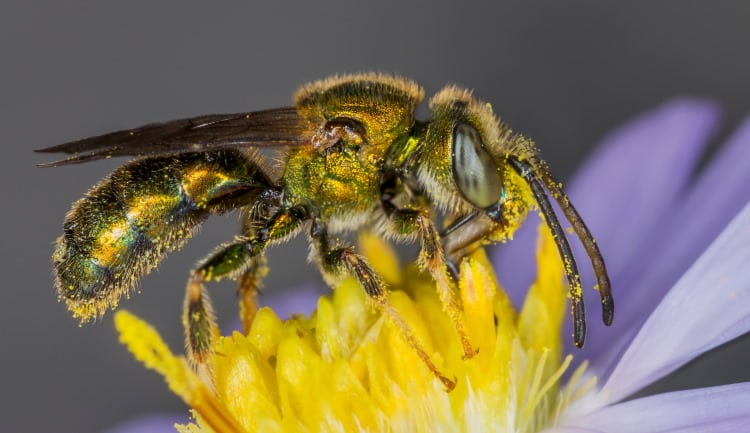
By ‘solitary’ we mean that a single female – after she emerges from her pupae and is mated by a male – constructs, provisions and lays an egg in each cell in a nest by herself. This is in comparison with social (called eusocial) bees like the Bumble Bees, Honey Bees, Sweat Bees and Stingless Bees – all of whom have a Queen who lays eggs and a number of workers who look after them.
Like everything else in life, this is not the end of the story.
These are two nice, neat descriptions which are really opposing ends of a continuum, i.e. there are some bees that not purely solitary but not really eusocial either. These are given various names such as, communal (i.e. Dialictus sp.) and semisocial (i.e. Augochlorella sp.) and quasisocial (i.e. Euplusia sp.) depending on how close they get to being ‘eusocial’.
Some bees nest in living or dead wood, sandstone and/or soil; while others construct nests in existing hollows using other materials such as soil, or plant material.
Communal Nesting
Though both Solitary Bees and Solitary Wasps build their nests individually, you still often find lots of the soil nesting species nesting together in a small area.
This is because they are often very fussy about where they build their nests and – if there is only a small area available that is suitable for nesting in, in any one neighbourhood – then everyone will want to nest there.
Hence you often get loads of Solitary Bees and/or Wasps nesting side by side in one place. The largest recorded aggregation is 423,000 female bees in an area of 1300 m2. Aggregations can continue over 20 years, or can become extinct. 15% of bee genera and sub-genera contain cleptoparasitic species.
Solitary Bee Mating Habits; Introduction
Many bees produce specific pheromones and these are often important in bringing the two sexes together. In some species such as Centris adani, the males deposit the marking pheromones on the female during copulation and this makes them unattractive to other males.
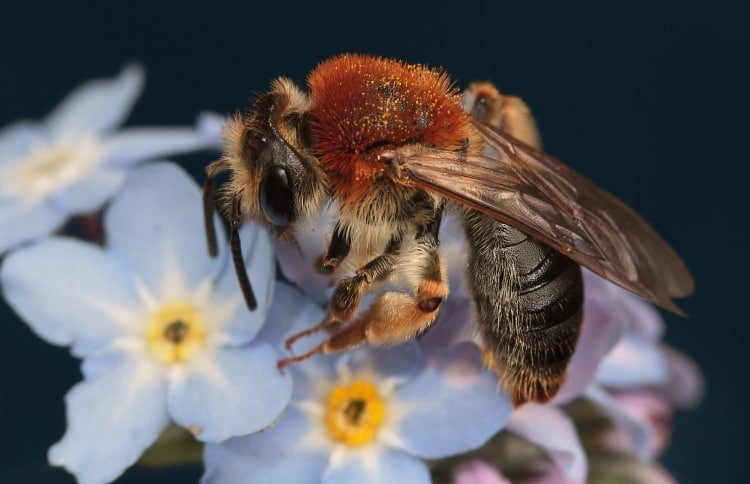
In some cleptoparasite genera such as Nomada, the males produce a pheromone in their mandibular glands which mimics the substances produced by the host’s Dufour’s gland. This is sprayed over the female during mating, presumably making it easier for the female to gain entry into the host’s nest.
Orchids of the genus Ophrys emit mimic pheromones, which attract male bees of whichever species is being mimicked. Males of Andrena, Anthophora, Colletes, Eucera and Tetralonia amongst others fall for these lures. The males attempt to mate with the flowers and end up pollinating them.
Females of most species only mate once. However, in a few other species the females are receptive all season, e.g. Panurgus spp. In some species of Nomadopsis and Perdita the male remains coupled with the female while she forages, thus preventing other males from mating with her.
The Male Solitary Bee’s Perspective
Protandry, i.e. males emerge before females is the norm in solitary bees and it means the males are waiting for the females when they emerge. Males live much shorter lives than females on average, and can often only be found at the beginning of a species’ season. Male and female bees often look quite different.
Males look for females at flowers, at the nest site where they emerged, and at other non-resource sites which are called ‘encounter sites’. In any one area, there may be one lone male patrolling from one encounter site to another – or there may be hundreds.
When the number of males is very large, they may form swarms and patrol synchronously from site to site. In some species such as Osmia rufa, the males may have home ranges which represent only a part of the total encounter sites available.
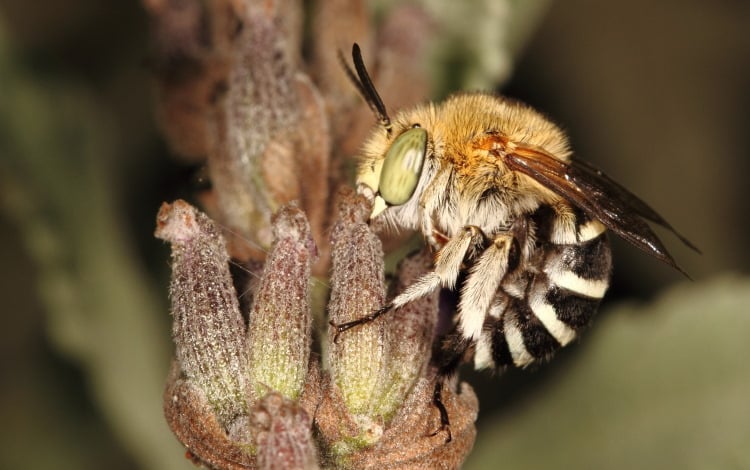
In some species, males mark the flowers that mark the boundaries of their range with pheromones.
In some non-aggressive bees such as Andrena, Nomada and Triepeolus, males may scent mark non-flowering plants to mark the edges of the patrol routes. These markings may be attractive to other males, which then join in the patrol.
When a receptive female is encountered by one male, he will attempt to mate with her. If more than one male is present, the others will probably also attempt to mate with her and a large mass of bees (all but one being male, they will tumble to the ground). Otherwise non-aggressive males may well fight when a receptive female is present.
Territoriality in Male Solitary Bees
In some more aggressive species, e.g. Anthidium manicatum and Hoplitis anthocopoides the males are territorial. Territorial males then either patrol their territory, e.g. Megachile and Callanthidium, or they can wait at a single encounter site which they defend from other males, e.g. species of Xylocopa.
As always in nature there are variants – and some Anthidium males patrol along a route when few other males are around, but switch to defending a single flower clump when other males are numerous. The size of male territories ranges from about 0.5m2 to 6m2.
Males probably never hold a territory for an entire breeding season and in some cases territories change owners after relatively short times. This is partly controlled by the density of resources and the amount of competition. In Anthidium manicatum it has been shown that the best territories are held by the largest males. And that territory holding males forage more and copulate more than do non-territory holding males.
In circumstances like this you get selection for large males and males tend to be larger than females.
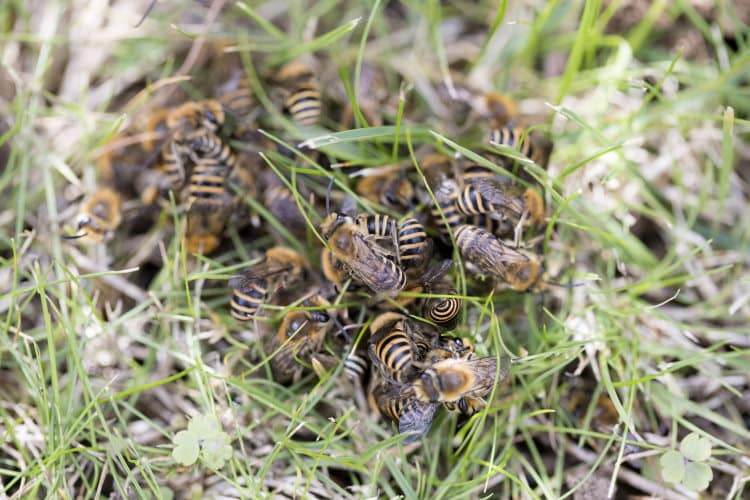
Copulation is normally brief and often involves the mating pair getting mobbed by all the nearby males. The exception to this is the Panurgines. Nomadopsis males may either find the female at a flower and fly with her ‘in copula’ to the nest, or vice versa, depending on the species.
In some gregarious nesters such as Anthophorines and Panurgines, mating takes place over the nesting site. Or else it can take place inside the burrow, as in some Andrena and Paracolletes. However, mating normally takes place at (or in) a flower being visited by the female for pollen; or as in the case of Nomia melanderi it occurs both at flowers and/or at the nest.
Males of some species of Andrena have been observed patrolling along hedgerows, presumably in order to maximise their chances of meeting and mating with a female.
Nests and Nest Building
Many solitary bees nest near where they emerged, especially soil, wood and wall nesting species. There may sometimes be hundreds of thousands nesting in one area. Most nest in the ground, in well drained soils of varying degrees of slope; however Megalopta ipomoeae is a nocturnal bee which nests in damp soil in tropical forests.
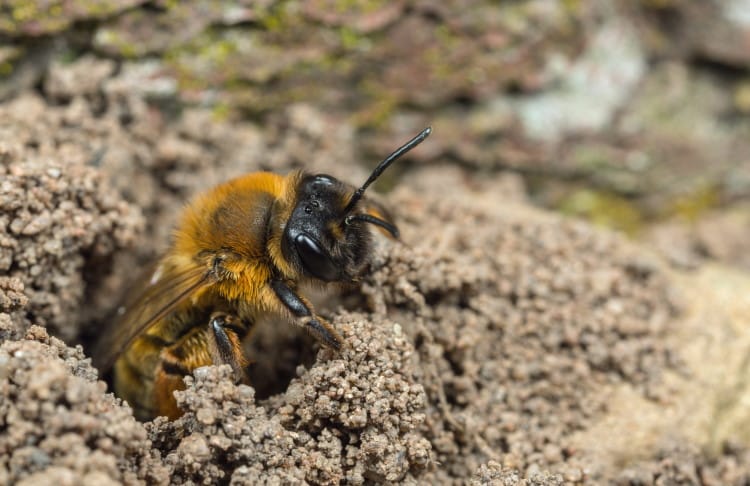
Most of the Bees which nest in plants use plants with pithy stems, i.e. bramble, raspberry, elder, maple or bamboo, whilst only a few, like Xylocopa sp. gnaw out holes in solid wood; and Megachile sp. and Osmia sp. use many different cavities, from holes made in wood or soil by other insects, to snail shells and man-made objects.
Many ground nesting species pile the soil from the burrows up in a little volcano hillock, around the nest (e.g. Andrena haemorrhoidalis); whilst others build entrance tubes or turrets. The depth of the burrow depends on the species and soil type; those that nest in very dry soil tend to dig deeper holes. The Xylocopines, most Anthophorines, Megachilids and some Colletids construct their nest cells end-on-end.
In most of the solitary bees, the cells are lined with wax or varnish-like waterproofing material and sometimes the tunnels of the Colletids are lined with a thin, cellophane-like material. These substances are secreted by the salivary glands in Andrenids, Colletids and Hallictids, but are abdominally secreted in the Anthophorines.
However Megachilids, the leaf cutters, use bits of leaf or petals – while some use mud and/or pebbles.
Bee genera and cell lining materials:
- Trachusa: leaf sections
- Heteranthidium: sand cemented with resin
- Dianthidium: pebbles
- Serapista: plant fibres stuck to trees
The cells are provisioned with pollen and usually some nectar in species of Andrena. The pollen is generally made into a dough-like ball with the nectar, but in Lithurge sp. it is left quite dry; whilst in many Colletids and Anthophorines the food may be a semi-liquid gruel. In most Anthophorines about half the food is liquid and this portion is eaten first.
Egg Laying and Larval Development
A few species lay their egg part way through provisioning the nest (e.g. Lithurge fuscipennis), but by far the most common procedure is to fully provision the nest then lay the egg and close the cell. Most lay the egg on the food but the Emphorines insert the egg under the food. Species of Colletes, Melecta and Nomada stick the egg onto the cell wall.
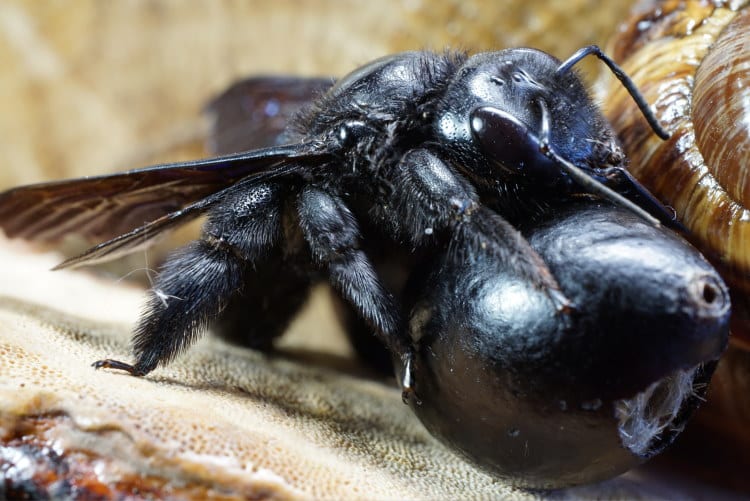
Development is usually quick, taking only a few weeks to pupation. The bee may then remain a pupa until a suitable emergence time. In species with more than one generation per year, this may be quite soon after pupation is finished. But in the many univoltine (having one generation per year) species it will mean over-wintering as a pupa.
Over-wintering may be extended to several years when the weather is poor. Alternatively, species like Andrena and Osmia emerge from the pupa and overwinter as inactive adults in the cell. Or, in some species of Xylocopa and Ceratina, may emerge in the fall and then overwinter gregariously in old burrows or other suitable places. Most do not form a cocoon, the exception to this is the Megachilids.
Nesting females normally nest/sleep in their burrows, while many males (and not yet nesting females) may gather into groups, often containing a mixture of species, consisting of up to several hundred bees for the night.
Some bees, like some Sphecid wasps, grasp the stem of a plant with their mandibles and let the rest of the body relax, either head up, or as in Coelioxys sp. with the head facing down. Others hold the stem with their legs as well, either head down (Melissodes obliqua and M. perplexa), or head up as in M. bimaculata. Nocturnal bees sleep in flowers during the day.
Foraging in Solitary Bees
All bees are dependent on flowers. Most bees show flower constancy to some extent, when collecting pollen; though individuals of one bee species may use different species of flowers – and individuals may change species of flower.
This is common among social bees such as Apis sp., Bombus sp. and Melipona sp. as well as semi-social bees such as Halictus sp. and many solitary bees such as Anthophora sp., Andrena sp. and Megachile sp.
Many solitary bees, however, are species specific to one or only a few species of flower. Those which visit one species are called ‘monolectic‘; those that visit a few species as ‘oligolectic‘; and the rest, those that visit many different species, are ‘polylectic‘.
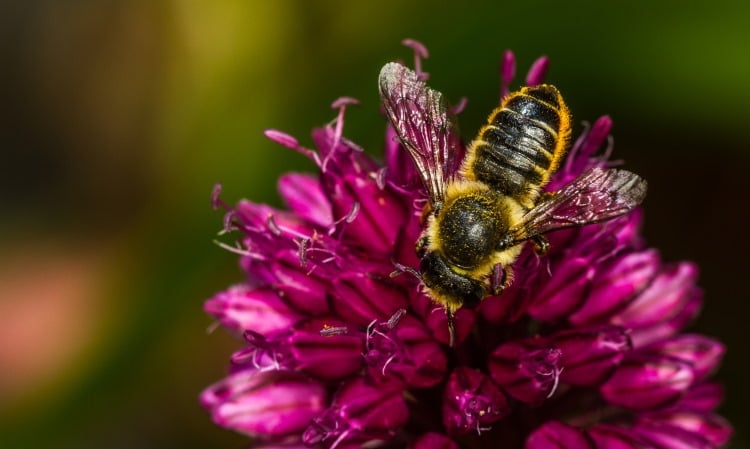
Oligolecty tends to occur more in temperate zones rather than in tropical regions. Because plants tend to flower at certain times of the year, monolectic bees must relate to this i.e. Andrena sp. on Salix are active only in early spring.
In some cases at least, it is now known that monolectic bees or oligolectic bees are more efficient at foraging on the chosen flowers than polylectic bees. I.e. Hoplitis anthocopoides is more efficient at foraging on Echium vulgare than several of the polylectic bees which also forage on it .
Some bees simply show colour preferences i.e. Megachile brevis prefers blue or purple flowers. Xylocopa virginica texana marks flowers it has visited with a short-lived repellent. This helps it avoid visiting the same flower twice.
Besides nectar and pollen, some flowers secrete oils from special floral glands called elaiophores. The bees that collect this oil have special morphological adaptations to their pollen gathering apparatus to assist them.
Monolectic Bees and their Flowers:
- Megachile strophostyles: Strophostyles helvola
- Andrena nothoscordi: Nothaxadum striatum
- Andrena florea: Bryony alba
- Cemolobus ipomoeae: Ipomoea pendurata
- Colletes brevicornis: Specularia perfoliata
Oligolectic Bees and their Flower Groups:
- Colletes armatus: Asteraceae
- Megachile generosa: Leguminosae
- Andrena macoupinensis: Salix
- Pseudopanurgus labrosiformis: Heliantheae
- Emphor bombiformis: Hibiscus
Nocturnal bees in the genera Perdita (and the sub-genera Sphecodogastra and Evylaeus) all collect pollen from Evening Primroses and other Oenothera and related Onagraceae.
Xenoglossa sp. forage at Curcubita (cucumber family) flowers before dawn. This is called matinal foraging, as opposed to crepuscular foraging – foraging after sunset. Nocturnal foraging bees tend to be large and dark; and to possess large ocelli.
Morphological Adaptations
Bees pollen apparatus is adapted to the flowers they use. Bees which collect from flowers with large pollen grains have loose, more open scopae (pollen baskets). Whilst those that specialise in the compositae have dense scopae to hold the smaller pollen grains.
Verbenapsis sp. have special hairs on their front tarsi to allow them to collect pollen from the tube protected anthers of Verbena.
You will often hear bees referred to as long and short tounged; this reflects the flowers they have adapted to specialise in.
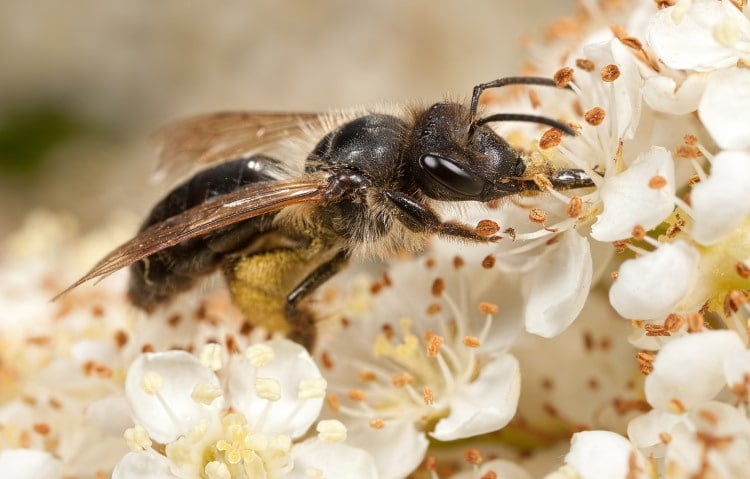
The tongue lengths relate to the lengths of the corolla. Many Anthophorines are long-tongued and visit deep flowers such as Ipomea sp., whereas short-tongued bees for instance are more likely to visit compositae.
Weather
Weather conditions affect both flowering plants and solitary bees. Ironically, the sort of late-winter early-spring weather which is good for flowering plants is bad for bees; while the dry weather which the bees prefer reduces the number of blooms on the flowers.
This is possibly because moisture favours the growth of fungi which attack the bees in the nest cells.
Bees, particularly species of Lasioglossum, will often remain in the nest burrows when the weather is cold or overcast; and sometimes will even remain there when the weather appears perfect for foraging.
This is probably a result of attempts to maximise reproductive success over more than one year, in those species which live to participate in two or more breeding seasons. Some may remain as a pupa for a whole season if the weather is not suitable – and leave emerging until the next year.
Solitary Bee Parasites
Solitary Bees have many enemies including ‘parasitic bees‘ which are bees that lay their eggs in completed but unsealed cells of other bees (these are referred to as their ‘hosts’ in the classical parasitological terminology).
The table below gives a few examples, giving you some idea of how common this occurrence is.
Having said that, the number of parasites must always remain far smaller than the number of hosts – in the same way that predators are always less frequent than their prey. Though there are many facultative cleptoparasites, cleptoparasitism can also occur on an opportunistic basis with many normally foraging bees.
It is interesting to note that in harmony with Emery’s rule (which states that cleptoparasitic species tend to be closely related to their hosts), that long-tongued cleptoparasitic bees usually have long-tongued bees as their hosts. However, some long-tongued bee cleptoparasites have learned to use short-tongued bee’s hosts; but no short-tongued bee cleptoparasites have learned to use long-tongued bee hosts.
Parasitic Bees and their known Hosts
| Parasitic Bee | The Host |
|---|---|
| Sphecodes | Halictus |
| Stelis | Heriades |
| Stelis | Hoplitis |
| Chelynia | Anthidium |
| Chelynia | Heriades |
| Chelynia | Hoplitis |
| Chelynia | Osmia |
| Dioxys | Anthidium |
| Dioxys | Megachile |
| Dioxys | Osmia |
| Coelioxys | Megachile |
| Nomada | Andrena |
| Nomada | Nomia |
| Holcopasites | Pseudopanurgus |
| Neopasites | Dufourea |
| Oreopasites | Nomadopsis |
| Townsendiella | Conanthalictus |
| Epeolus | Colletes |
| Triepeolus | Melissodes |
| Epeoloides | Macropis |
| Melecta | Anthophora |
| Xeromelecta | Anthophora |
| Zacosmia | Anthophora |
| Ericrocis | Anthophora |
Parasitic bees are not a solitary bee’s only problems though. There are quite a number of other invertebrates who are willing to take advantage of the solitary bee’s work.
These include Oil Beetles, Bee Flies, Velvet Ants (Mutilidae), Rubytailed Wasps (Chrysididae), Sapygids and various Ichneumons and other parastic wasps. Oil beetles (Melloidae) and Bee Flies (Bombyliidea) are similar in the way they attack the solitary bees.
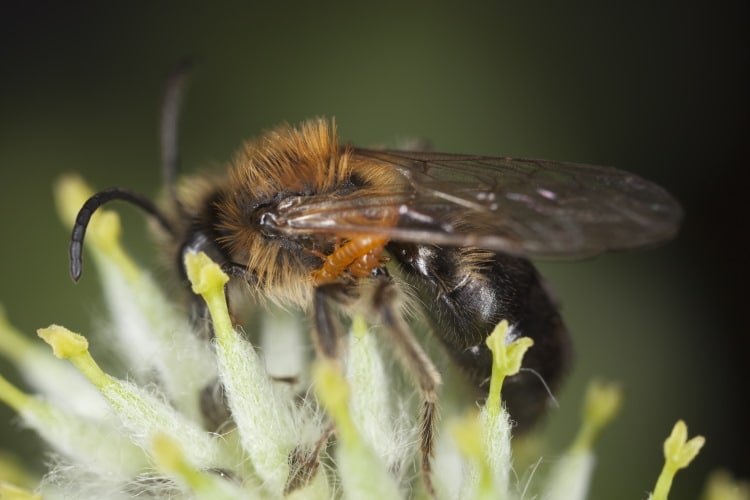
They lay their eggs at ground level, near the bee’s nest or near flowers likely to be visited by certain solitary bees. The larvae are fast moving, lice-like creatures in their first instar – and either find their own way quickly to the bee’s nest, or climb up to a flower to wait for a bee. They then catch a lift to the bee’s nest from her, whilst she visits the flower. On arriving at the nest, the little parasite first eats several of the host’s eggs and then starts feeding on the nectar and pollen stores.
In Europe, nearly all the Meloe are parasites on solitary bees; however in other parts of the world, their more common prey are grasshoppers. Apart from all these problems, many solitary bees die in their cells as lavae – having fallen prey to one of a number of fungi which like to grow on them.
In a study of two populations of Anthophora busleyi, Linlsey and MacSwain in 1942 found 22 different organisms in the bee’s nests – of which at least 18 would cause the death of the bee larvae or pupa.
The Flower Bee: a closer look at Anthophora plumipes
Anthophora plumipes is the Flower Bee or Plume-legged Bee. Like many solitary bees, it is usual for the males to be seen first; it was nearly two weeks after the first males emerged, before I saw any females this year.
This is because the female Flower Bee makes her nest in a long hole, with the cells that contain the eggs placed one after another. This means that the egg she lays first is the last bee to leave the nest next spring, and visa-versa, i.e. that the last egg she lays is the first bee to leave the nest.
In all Hymenopterans, the sex of an adult insect is controlled by whether or not the egg is fertilised before it is laid; fertilised eggs produce females and unfertilised eggs produce males. Therefore, because she can control whether or not to let the sperm she received from the male fertilise any given egg before she lays it (and because she always lays fertilised eggs first and unfertilised eggs last), the female Flower Bee ensures that next spring it is always the males that we see first.
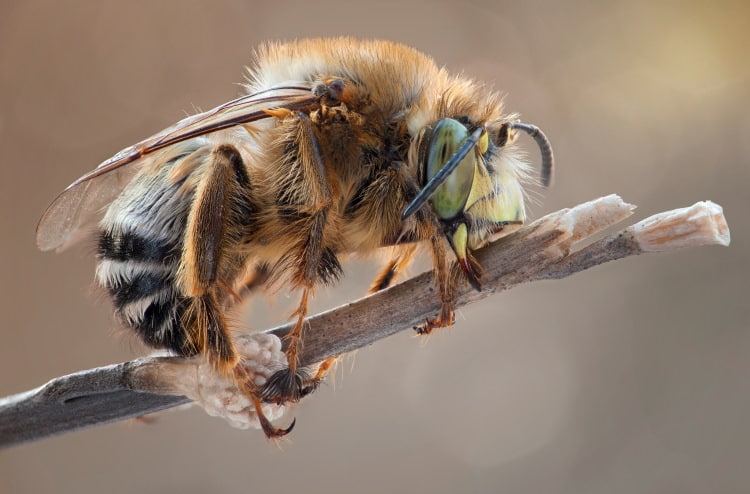
Anthophora plumipes are lovely bees – they are the size of a small bumble bee and make a sound that is similar, but higher in pitch. The male is a tawny/orange colour with a patch of plumose hairs on the tarsi of his middle legs; and a yellow face. Both sexes have very long tongues ,which you can easily see as the bee hovers in front of a flower.
The Female Flower Bee
In South-West Europe including Britain, the female is an all black bee with orange hairs making up her pollen basket on her hind legs. But in South-East Europe, the Middle East and beyond, she is the same colour as the male; nobody seems to know why the female is a different colour in some places.
The Flower Bee is a low, very fast flying bee; in the hotter places where it lives, such as the Sinai Desert in Israel, it uses its fast flight to keep cool. It does this by pumping all its blood into its abdomen, so that as much of it as possible will be cooled by the quickly passing air.
The females are very cautious and tend to fly off at the slightest sign of trouble. Besides making them hard to catch, this makes it difficult for the males to get them to sit still long enough to mate.
To solve this problem, the male uses the plumes on his middle legs to cover the eyes of the females during mating, so that she won’t get spooked and fly off half way through.
The Male Flower Bee
The males are territorial and tend to guard a home range, which contains either the sorts of flowers the females like to visit, or a site suitable for nesting.
They nest in the holes between the stones in the walls of the 14th century Manor House at North Wyke where I work, but they also like cliff faces and will even nest in the ground if that is all they can find – though they prefer vertical surfaces.
The male Flower Bee patrols around his home range, spending time at each patch of flowers and/or nest site chasing off intruders. He is very serious about this and defends his chosen resources from all comers, whether they are a competing male bee or not.
To drive intruders away from his range, he accelerates straight at them very quickly and rams them with his head. He can knock out insects much larger than himself this way!
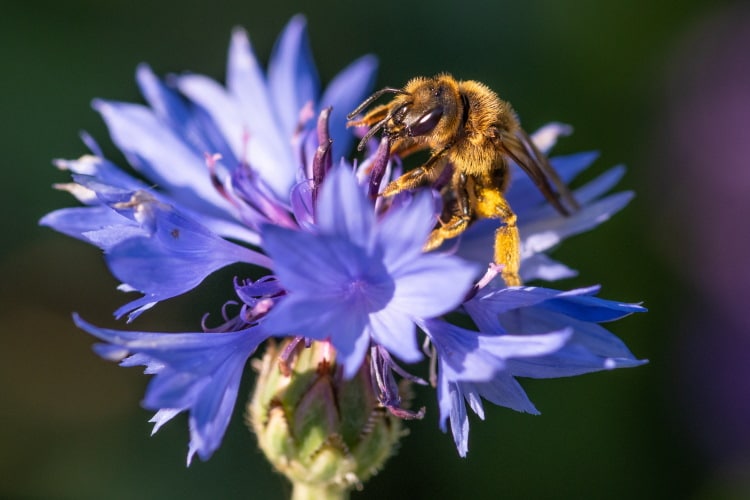
If you have a lot of Flower Bees around, you may well find another rather attractive bee – with nasty habits hanging around the nest holes. This is Melecta armata, which is a brood parasite or Cuckoo bee; it lays its eggs in the nest of A. plumipes, after she has stocked them and layed her egg.
The M. armata larvae hatches first, then proceeds to eat the Flower Bee’s egg before devouring its store of food as well. Bees like this can be recognised because they do not collect pollen and therefore have no pollen baskets.
Anthophora bees are very successful and though we only have four species in Britain, there are many in warmer parts of the world – for instance there are over 100 in Israel.
What Next?
Well, I hope this has been an interesting look into the world of the solitary bees! Perhaps take an even closer look at bees and the flowers they pollenate with a stereo microscope?
Make sure you check out Saunders 1896 monograph on the Aculeates of Britain, this is a wonderful work of historic interest which was the classic text on British aculeates for many years. It contains many fine, hand-coloured plates.

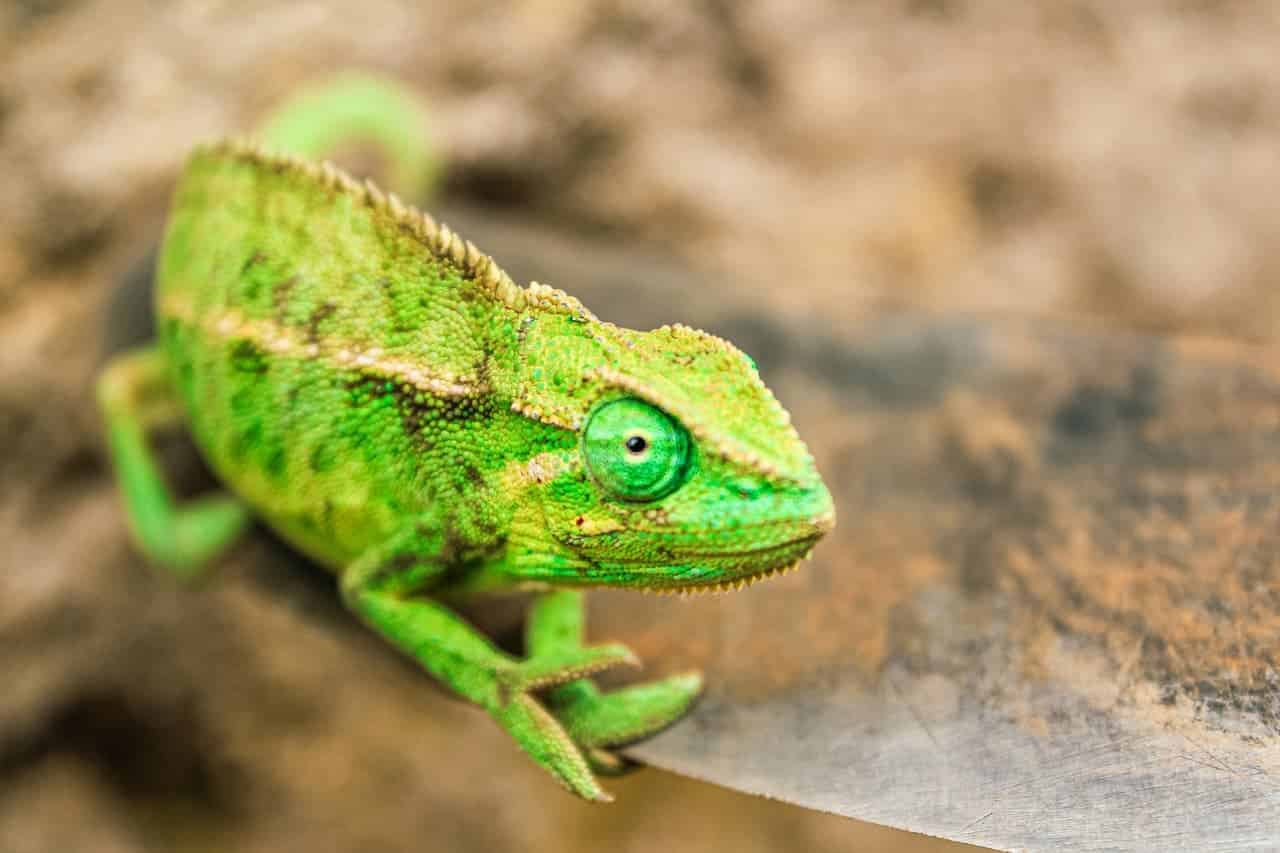

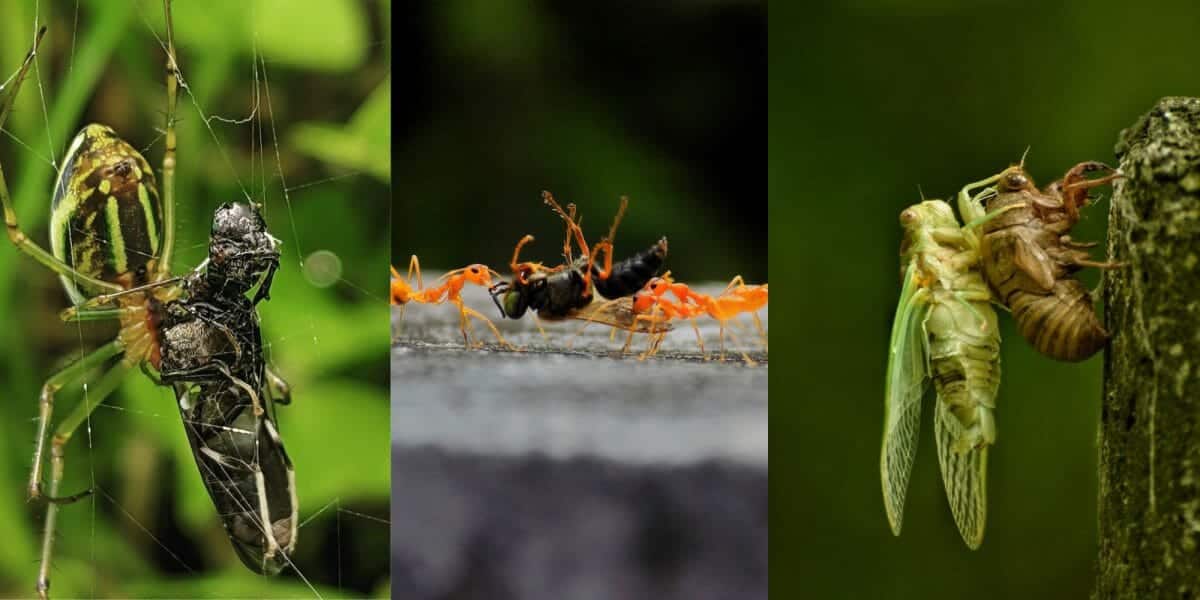

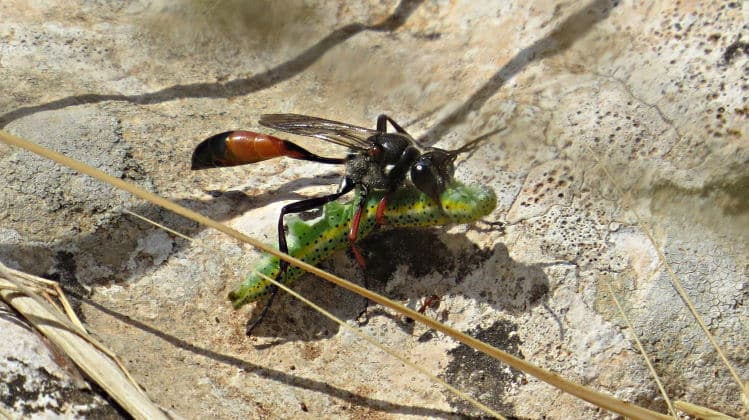
Thank you for all the great information, was wondering what the bees seal the holes with, after laying their eggs. We made a bee habitat in our yard this year and there were many sealed holes, with I’m assuming bee eggs inside. Do the bees gather materials or make the sealant themselves? And wondering if it varies by region and species? We live in Pennsylvania.
Different species of bees seal their holes with different substances, both secreted and gathered. Honey bees use wax, which they secrete themselves, other bees secrete other substances, Hyleoides concinna secretes a cellophane like substance. Various bees use some materials from the world around them, leaf-cutter bees use cut sections of leaf, however they secrete their own glue, carpenter bees use chewed wood pulp, etc.
Terrific photos and great information. Thanks for being such a great resource.
I love your site, but why do you have a photo of a syrphid fly as the headliner?
Hi Bette, Thanks for the heads up. The answer is that I was away from the site for a number of years, my new partner who up-dated it to wordpress while I was away added a lot of photos at the same time. He is great with the tech and SEO side of things but he is not a zoologist. I have checked a lot, but not all of the 350 plus pages that make up the site. You will see I have updated Solitary Bees with a picture of Xylocopa aestuans taken in my garden a couple of months back. Please do report anymore errors you find.